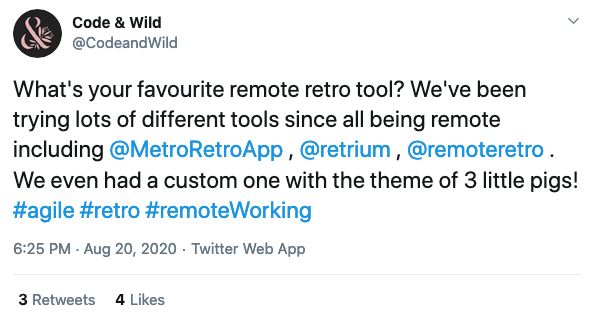Succeeding with Remote Retrospectives
21 Oct 2020

Obviously 2020 has been a challenging year all round.
In particular, when work groups meet to reflect on their recent work, now that these retrospectives are taking place virtually, extra challenges present themselves.
Recently, as part of the mini-LAST #2 conference, I presented what was partly some of my suggestions and partly a facilitation of discussions about succeeding with remote retrospectives. I promised to share the outcomes. Hence this blog post.
Motivation
The first of three aspects that I covered was a fundamental one. Remote or in person, why would a team want to hold a retrospective anyway?
Share recent successes
In my view a good, positive reason to hold a retrospective is to reflect on recent successes. I recall occasions in my career when, at the end of a project, the team celebrated with a lunch paid for by the company. In these times of more iterative software development, I think it’s healthy to regularly celebrate recent achievements as a team. This can be done as part of a retrospective and helps to build team morale.
Reduce frustration
As well as sharing reflections on things that went well, a key motivation to hold a retrospective may to allow team members to voice their views about sub-optimal experiences. Providing a forum in which to let people to get things “off their chest” is important so that negativity does not build.
Emphasise the Prime Directive
Whilst I think it’s useful to allow people to comment on negative aspects of their recent work, it’s important that the team approach the retrospective in good spirit. This is reflected in what Norm Kerth proposed as the Prime Directive:
“Regardless of what we discover, we understand and truly believe that everyone did the best job they could, given what they knew at the time, their skills and abilities, the resources available, and the situation at hand.”
So, it’s not a witch hunt! A healthy retrospective needs to acknowledge this as a premise.
Discuss questions
During the last iteration, sprint or whatever name your team has given to the period of time which you are reflecting upon, questions may have arisen. Encouraging team members to share uncertainties may lead to fruitful discussion, perhaps resulting in answers or actions that can lead to improvement.
Ideas from the audience
Having presented a few of my suggestions, I opened up discussion to seek more ideas from the audience about motivations for holding retrospectives. These included:
- to improve;
- because it’s expected by management;
- to build team rapport;
- to bond as a team
The second suggestion was somewhat cynical but nevertheless important to recognise. Unless there is genuine desire from the team to engage in a retrospective, it’s less likely to result in positive outcomes like improving teamwork.
Remote Challenges
Unsurprisingly the major aspect of my talk was to consider the challenges to holding a retrospective remotely.
Equal participation
It’s important that each person participating in the retrospective feels that they are getting a fair go. In a remote retrospective this implies that each person participates via their own video connection.
Before the onset of COVID-19 I can recall many retrospectives in which I was the only remote participant. Depending on the camera position in the room where everyone else was, this was at times quite disconcerting. Many times I felt like an outsider, having to say “excuse me” when I wanted to get a word in. And then everyone else looked at the camera. Contrast this everyone connecting with their own video camera as is more likely to be the case now that everyone is working from home.
Happily, I can also recall being part of retrospectives where I was the only remote participant and the co-located participants each took their laptop to a different part of the office and connected as if they were remote. It’s easy enough to do but, in my view, a very important step.
Audio and video
As with any online meeting, it helps to ensure that audio and video technology is working well. Invest in good microphones, make sure your software is configured to use them and prefer ethernet to wifi connections. Simple attention to these details will enable you to communicate seamlessly. For example, I know that in my home office the wifi connection in my office is not sufficient for smooth video.
Another simple tip is to set up your computer so that the camera is at a good height to enable others to see you at a natural angle.
Do everything you can to avoid distractions from good verbal and visual communication.
Retro tool
In a retrospective where everyone’s in the same physical room, a white board and post-it notes can be used.
When at least one participant is remote, this low fidelity approach breaks down. An online tool is needed. Whilst general purpose tools can be used, I favour one that is built for the purpose.

A couple of months ago this tweet posed a question about which remote retro tool people preferred. Now at this point I need to disclose that I am a co-founder of one of the tools mentioned, RemoteRetro. How I came to be a co-founder of this tool is another story, which I may make the subject of another post.
Suffice to say, to enable everyone to equally participate in a remote retrospective, you’ll need to choose one or more tools for online collaboration.
Facilitation
Facilitation is even more important when participants are remote. The facilitator will need to guide the team’s use of the retro tool as well as communicate effectively with participants via the video tool.
Variety
What format will the retro take? Don’t allow retros to become boring by choosing the same format each time.
For example, RemoteRetro, as well as allowing custom formats to be created, offers four pre-set formats:
- Good/Bad/Actions/Questions
- Start/Stop/Continue
- Mad/Sad/Glad
- Liked/Learned/Loathed/Longed For
Share ideas
In order to promote useful discussion the facilitator will need to encourage all participants to contribute ideas via the retro tool.
Facilitate discussion
Once ideas have been shared via the retro tool, at the very lest the facilitator needs to guide the resulting discussion.
Ideas from the audience
When we further discussed remote challenges as a group, the following ideas were generated:
- make sure that genuine variety occurs, not just different formats or recipes
- changing the focus of each retrospective can help
- we need to follow up ideas that require action
- a live, anonymous, interactive polling tool called Mentimeter was recommended to collect views from the team
- other retro tools that were recommended included Metro Retro, FunRetro and RetroBoard
- general purpose tools that audience members use for retros included MURAL and Miro
Enabling Improvement
To round out this presentation and discussion, I wanted to focus on improvement. Quite simply, if a retrospective doesn’t result in improvements for the team, it’s hard to justify holding it in the first place.
Note action items
Capture suggestions for actions arising from the discussion.
Use your chosen tool(s) to note action items and agree on who should be assigned to them.
Support for tracking action items
It’s important that action items are completed before the next retrospective. Otherwise, the team can become demotivated. They may start questioning the point of holding retrospectives in the first place.
A combination of using tools well and personal as well as team commitment to following through must support good intentions.
Ideas from the audience
Some ideas about enabling improvement that the audience suggested were:
- don’t hold retros at 4pm on a Friday!
- commit to realistic actions so that improvement has more chance of resulting
- use the Heart of Agile as a prism for enabling improvement
- use a Futurespective approach
In Conclusion
I would like to thank all who were involved in the mini-LAST #2 online conference, especially Ed Wong for enabling me to present. To those who listened and participated, a big thank you for what you contributed. Even though I’ve been an enthusiastic participant and facilitator of remote retrospectives for quite a few years, I know I still have plenty to learn.
Postscript
Speaking of having plenty to learn, this morning I was alerted to the fact that Aino Vonge Corry’s Retrospectives Antipatterns book was available. Having anticipated it for some time, I quickly took the opportunity to purchase it and start reading it. I’m sure that there will be many nuggets therein from which I can improve my own facilitation of retrospectives.
Other posts
Previous post: On Working Remotely
More recently: Recent Reading